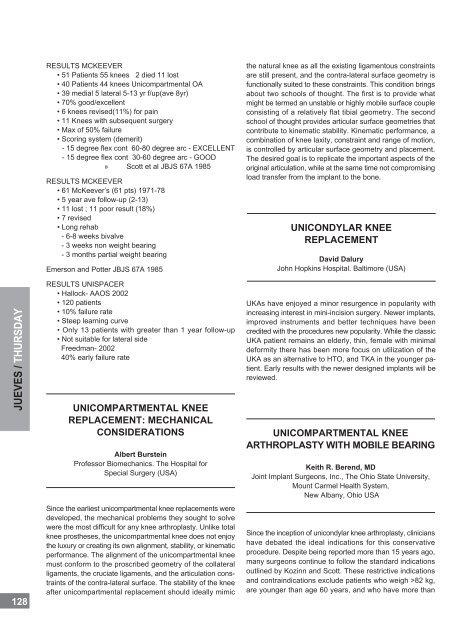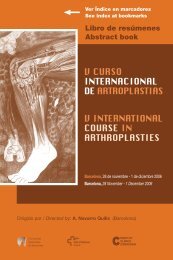Notas / Notes - Active Congress.......
Notas / Notes - Active Congress.......
Notas / Notes - Active Congress.......
Create successful ePaper yourself
Turn your PDF publications into a flip-book with our unique Google optimized e-Paper software.
JUEVES / THURSDAY<br />
128<br />
RESULTS MCKEEVER<br />
• 51 Patients 55 knees 2 died 11 lost<br />
• 40 Patients 44 knees Unicompartmental OA<br />
• 39 medial 5 lateral 5-13 yr f/up(ave 8yr)<br />
• 70% good/excellent<br />
• 6 knees revised(11%) for pain<br />
• 11 Knees with subsequent surgery<br />
• Max of 50% failure<br />
• Scoring system (demerit)<br />
- 15 degree flex cont 60-80 degree arc - EXCELLENT<br />
- 15 degree flex cont 30-60 degree arc - GOOD<br />
» Scott et al JBJS 67A 1985<br />
RESULTS MCKEEVER<br />
• 61 McKeever’s (61 pts) 1971-78<br />
• 5 year ave follow-up (2-13)<br />
• 11 lost ; 11 poor result (18%)<br />
• 7 revised<br />
• Long rehab<br />
- 6-8 weeks bivalve<br />
- 3 weeks non weight bearing<br />
- 3 months partial weight bearing<br />
Emerson and Potter JBJS 67A 1985<br />
RESULTS UNISPACER<br />
• Hallock- AAOS 2002<br />
• 120 patients<br />
• 10% failure rate<br />
• Steep learning curve<br />
• Only 13 patients with greater than 1 year follow-up<br />
• Not suitable for lateral side<br />
Freedman- 2002<br />
40% early failure rate<br />
UNICOMPARTMENTAL KNEE<br />
REPLACEMENT: MECHANICAL<br />
CONSIDERATIONS<br />
Albert Burstein<br />
Professor Biomechanics. The Hospital for<br />
Special Surgery (USA)<br />
Since the earliest unicompartmental knee replacements were<br />
developed, the mechanical problems they sought to solve<br />
were the most difficult for any knee arthroplasty. Unlike total<br />
knee prostheses, the unicompartmental knee does not enjoy<br />
the luxury or creating its own alignment, stability, or kinematic<br />
performance. The alignment of the unicompartmental knee<br />
must conform to the proscribed geometry of the collateral<br />
ligaments, the cruciate ligaments, and the articulation constraints<br />
of the contra-lateral surface. The stability of the knee<br />
after unicompartmental replacement should ideally mimic<br />
the natural knee as all the existing ligamentous constraints<br />
are still present, and the contra-lateral surface geometry is<br />
functionally suited to these constraints. This condition brings<br />
about two schools of thought. The first is to provide what<br />
might be termed an unstable or highly mobile surface couple<br />
consisting of a relatively flat tibial geometry. The second<br />
school of thought provides articular surface geometries that<br />
contribute to kinematic stability. Kinematic performance, a<br />
combination of knee laxity, constraint and range of motion,<br />
is controlled by articular surface geometry and placement.<br />
The desired goal is to replicate the important aspects of the<br />
original articulation, while at the same time not compromising<br />
load transfer from the implant to the bone.<br />
UNICONDYLAR KNEE<br />
REPLACEMENT<br />
David Dalury<br />
John Hopkins Hospital. Baltimore (USA)<br />
UKAs have enjoyed a minor resurgence in popularity with<br />
increasing interest in mini-incision surgery. Newer implants,<br />
improved instruments and better techniques have been<br />
credited with the procedures new popularity. While the classic<br />
UKA patient remains an elderly, thin, female with minimal<br />
deformity there has been more focus on utilization of the<br />
UKA as an alternative to HTO, and TKA in the younger patient.<br />
Early results with the newer designed implants will be<br />
reviewed.<br />
UNICOMPARTMENTAL KNEE<br />
ARTHROPLASTY WITH MOBILE BEARING<br />
Keith R. Berend, MD<br />
Joint Implant Surgeons, Inc., The Ohio State University,<br />
Mount Carmel Health System,<br />
New Albany, Ohio USA<br />
Since the inception of unicondylar knee arthroplasty, clinicians<br />
have debated the ideal indications for this conservative<br />
procedure. Despite being reported more than 15 years ago,<br />
many surgeons continue to follow the standard indications<br />
outlined by Kozinn and Scott. These restrictive indications<br />
and contraindications exclude patients who weigh >82 kg,<br />
are younger than age 60 years, and who have more than





